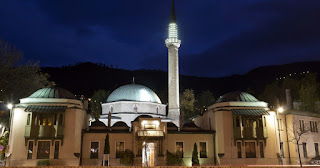The Ottoman’s introduced Islam into Bosnia and built several mosques. Many of the 16th-century buildings remain today. Sarajevo, Bosnia’s capital, has lots of mosques near Bascarsija, the old bazaar area, and even more in the surrounding hills. Here are some of the most beautiful mosques to check out on your trip to Bosnia.
Gazi Husrev-bey Mosque, Sarajevo
Today, Gazi Husrev-bey Mosque has some of the best Classical Ottoman architecture. It’s also the largest in the country. Several influential Bosnians, including politicians, rest in the adjoining cemetery. Non-Muslims can enter the building outside of prayer time.
You’ll see the Sarajevo Clock Tower next to the mosque built in the 17th-century. Many tourists and some locals think it’s broken, and in typical Sarajevian fashion has never been repaired. You might think the same when you hear the clock striking midnight in the evening. It’s not broken. In fact, the claim to fame is that it strikes at sundown making it one of the only remaining clocks in the world on lunar time.
Saraci 8, Sarajevo 71000, Bosnia and Herzegovina. Tel +387 33 532-144.
Ferhat Pasha Mosque, Banja Luka
Architecturally, the exterior has a typical classical Ottoman design with the central dome reaching 18 metres (59 feet) and the minaret 43 metres (141 feet). Compared to others, Ferhat Pasha Mosque is relatively small. The outside has a courtyard, fountain and prominent Bosnians buried in the graveyard.
Unfortunately, in 1993 Bosnian Serbs demolished the building in the recently proclaimed Republika Srpska, a region with an Orthodox Christian Serb majority. Rebuilding began in the 21st century and ended in 2016.
Kralja Petra I Karađorđevića, Banja Luka 78000, Bosnia and Herzegovina. Tel: +387 51 211-840
Emperor’s Mosque, Sarajevo
Emperor’s has been rebuilt and expanded several times in the 550-year history. It started as a wooden mosque catering for the relatively few residents. Now, 500 worshipers can pray inside. And, in case you’re wondering, the mosque’s name doesn’t refer to Isa but to Mehmed the Conqueror instead. Ottoman Mehmed took Constantinople from the Byzantines. Many believe Isa Bey Ishakovic’s rests in the cemetery.
Obala Isa-bega Ishakovića, Sarajevo 71000, Bosnia and Herzegovina.
Ali Pasha Mosque, Sarajevo
Hamze Hume, Sarajevo 71000, Bosnia and Herzegovina.
Ferhadija Mosque, Sarajevo
Governor Ferhad-Beg Vukovic ordered the mosque in the 16th century on the outskirts of Bascarsija on the corner of Ferhadija and Vladislava Skarica. Architecturally, the classical style, like others of the time, has a large dome with three smaller domes over the building’s arches.A children’s school and public kitchen once joined the main prayer hall in Ferhadija Mosque. Non-Muslims can enter. You can see several layers of paintings and murals on the wall, which date back centuries. Reconstruction ended in 2007.
Ferhadija, Sarajevo 71000, Bosnia and Herzegovina.
Karadoz Bey Mosque, Mostar
If you’re in Mostar, walk to the north of Stari Most through the Old Bazaar area, and you’ll reach it. Karadoz Bey Mosque suffered substantial damage during World War II and the Bosnian War. Renovation finished in the early 2000s.
Braće Fejića, Mostar 88000, Bosnia and Herzegovina.
Turalibeg’s Mosque, Tuzla
Not every mosque in Bosnia has the typical Classical Ottoman styles so prevalent in Sarajevo and Mostar. Instead, Turalibeg’s has a distinctive design rare in the Islamic world. Instead of a dome, the roof has a pyramid shape with an adjacent minaret. After a 2007 renovation, the mosque retains its original features with a modern style. If you like architecture and a fan of Bosnia’s mosques, check out Turalibeg’s in Tuzla.Turalibegova, Tuzla 75000, Bosnia and Herzegovina.








